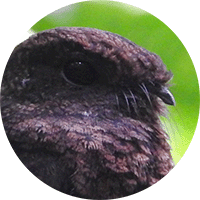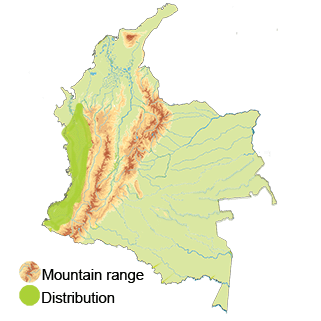Choco Poorwill
The Choco Poorwill (Nyctiphrynus rosenbergi) Read in Spanish
Appearance: The Choco Poorwill is a small, cryptic bird with a distinctive appearance. It has mottled brown and black plumage with intricate patterns that provide excellent camouflage against the forest floor. The bird has a large head, wide mouth, short legs, and a rounded body ideal for its nocturnal habits.
Habitat: The Choco Poorwill is primarily found in the dense and humid lowland forests of the Chocó region in western Colombia.
- It inhabits the forest understory, where it roosts on the ground or low branches during the day, relying on its camouflage for protection.
Behavior: As a nocturnal species, the Choco Poorwill is active at night, foraging for insects and other small invertebrates. It is a primarily insectivorous bird, using its wide mouth to catch flying insects in mid-air. The Choco Poorwill is known for its stealthy and elusive behavior, making it challenging to spot despite its relatively common distribution.
Breeding: Breeding behavior of the Choco Poorwill includes courtship displays, which may involve vocalizations and aerial acrobatics. The female typically lays one or two eggs on the forest floor, where they are incubated for a period before hatching. Both parents may participate in caring for the young birds once they hatch.
Conservation Status: The Choco Poorwill is classified as "Least Concern" on the IUCN Red List.
Distribution
The Choco Poorwill (Nyctiphrynus rosenbergi)
Chocó Region: The Choco Poorwill is primarily associated with the Chocó biogeographic region, which encompasses parts of western Colombia along the Pacific coast. Within the Chocó region, the bird inhabits the dense and humid lowland forests, where it roosts in the understory vegetation during the day. This region is known for its high levels of biodiversity and endemism, making it a critical habitat for species like the Choco Poorwill.
Pacific Coast of Colombia: The Choco Poorwill's distribution extends along the Pacific coast of Colombia within the Chocó region.
The bird is adapted to the unique environmental conditions of this region, including its dense forests and high levels of rainfall. The Pacific coast provides suitable habitat for the Choco Poorwill's foraging and breeding activities.
Taxonomy
The Choco Poorwill (Nyctiphrynus rosenbergi)
- Kingdom: Animalia
- Phylum: Chordata
- Class: Aves (Birds)
- Order: Caprimulgiformes
- Family: Caprimulgidae
- Genus: Nyctiphrynus
- Species: Nyctiphrynus rosenbergi
Vocalization
The Choco Poorwill (Nyctiphrynus rosenbergi)
- Calls: The Choco Poorwill produces a variety of calls, often heard during the night in its habitat within the dense and humid forests of the Chocó region. Its vocalizations are characterized by a series of high-pitched, repetitive notes that can be described as a soft, melodious trill or a rapid chattering sound.
- Nighttime Vocalization: The Choco Poorwill is most vocal during the nighttime when it is actively foraging for insects and communicating with other members of its species. The bird's calls are believed to serve various functions, including maintaining contact with mates, establishing territories, and signaling alarm or distress.
- Courtship Calls: During the breeding season, the Choco Poorwill may engage in courtship vocalizations as part of its mating behavior. These calls are often more elaborate and rhythmic, possibly involving duets between male and female birds to strengthen pair bonds.
- Communication: Vocalizations play a crucial role in the communication and social interactions of the Choco Poorwill, allowing individuals to coordinate activities, defend territories, and attract mates. The bird's vocal repertoire is an important aspect of its behavioral ecology and contributes to its survival and reproductive success in the wild.




